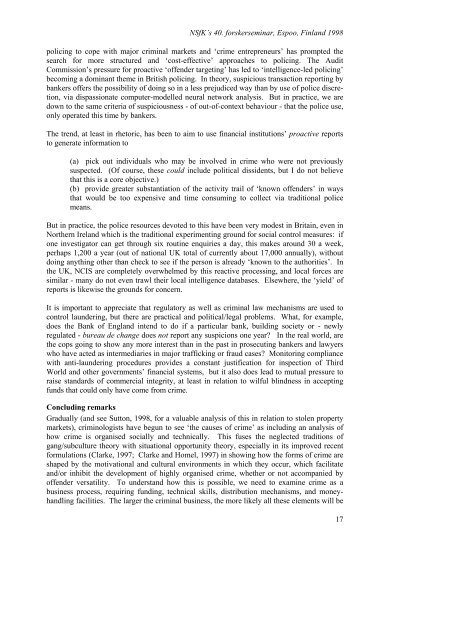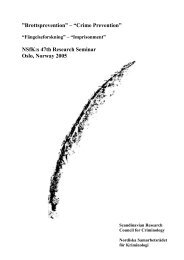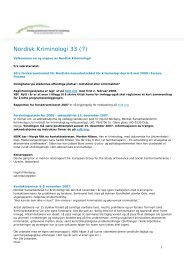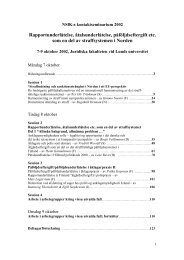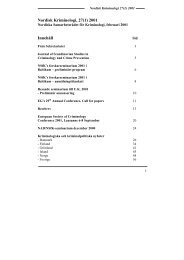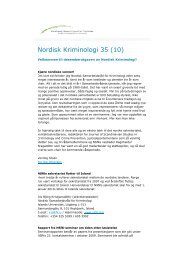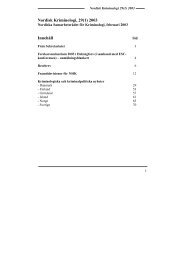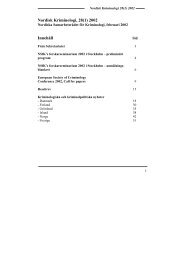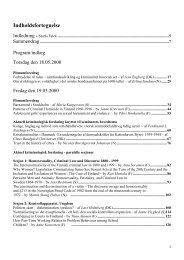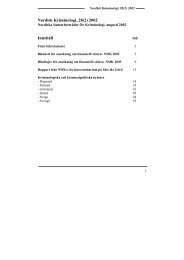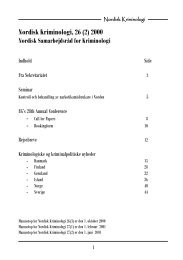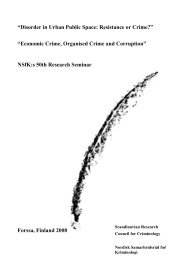Organised Crime & Crime Prevention - what works? - Scandinavian ...
Organised Crime & Crime Prevention - what works? - Scandinavian ...
Organised Crime & Crime Prevention - what works? - Scandinavian ...
Create successful ePaper yourself
Turn your PDF publications into a flip-book with our unique Google optimized e-Paper software.
NSfK’s 40. forskerseminar, Espoo, Finland 1998<br />
policing to cope with major criminal markets and ‘crime entrepreneurs’ has prompted the<br />
search for more structured and ‘cost-effective’ approaches to policing. The Audit<br />
Commission’s pressure for proactive ‘offender targeting’ has led to ‘intelligence-led policing’<br />
becoming a dominant theme in British policing. In theory, suspicious transaction reporting by<br />
bankers offers the possibility of doing so in a less prejudiced way than by use of police discretion,<br />
via dispassionate computer-modelled neural network analysis. But in practice, we are<br />
down to the same criteria of suspiciousness - of out-of-context behaviour - that the police use,<br />
only operated this time by bankers.<br />
The trend, at least in rhetoric, has been to aim to use financial institutions’ proactive reports<br />
to generate information to<br />
(a) pick out individuals who may be involved in crime who were not previously<br />
suspected. (Of course, these could include political dissidents, but I do not believe<br />
that this is a core objective.)<br />
(b) provide greater substantiation of the activity trail of ‘known offenders’ in ways<br />
that would be too expensive and time consuming to collect via traditional police<br />
means.<br />
But in practice, the police resources devoted to this have been very modest in Britain, even in<br />
Northern Ireland which is the traditional experimenting ground for social control measures: if<br />
one investigator can get through six routine enquiries a day, this makes around 30 a week,<br />
perhaps 1,200 a year (out of national UK total of currently about 17,000 annually), without<br />
doing anything other than check to see if the person is already ‘known to the authorities’. In<br />
the UK, NCIS are completely overwhelmed by this reactive processing, and local forces are<br />
similar - many do not even trawl their local intelligence databases. Elsewhere, the ‘yield’ of<br />
reports is likewise the grounds for concern.<br />
It is important to appreciate that regulatory as well as criminal law mechanisms are used to<br />
control laundering, but there are practical and political/legal problems. What, for example,<br />
does the Bank of England intend to do if a particular bank, building society or - newly<br />
regulated - bureau de change does not report any suspicions one year? In the real world, are<br />
the cops going to show any more interest than in the past in prosecuting bankers and lawyers<br />
who have acted as intermediaries in major trafficking or fraud cases? Monitoring compliance<br />
with anti-laundering procedures provides a constant justification for inspection of Third<br />
World and other governments’ financial systems, but it also does lead to mutual pressure to<br />
raise standards of commercial integrity, at least in relation to wilful blindness in accepting<br />
funds that could only have come from crime.<br />
Concluding remarks<br />
Gradually (and see Sutton, 1998, for a valuable analysis of this in relation to stolen property<br />
markets), criminologists have begun to see ‘the causes of crime’ as including an analysis of<br />
how crime is organised socially and technically. This fuses the neglected traditions of<br />
gang/subculture theory with situational opportunity theory, especially in its improved recent<br />
formulations (Clarke, 1997; Clarke and Homel, 1997) in showing how the forms of crime are<br />
shaped by the motivational and cultural environments in which they occur, which facilitate<br />
and/or inhibit the development of highly organised crime, whether or not accompanied by<br />
offender versatility. To understand how this is possible, we need to examine crime as a<br />
business process, requiring funding, technical skills, distribution mechanisms, and moneyhandling<br />
facilities. The larger the criminal business, the more likely all these elements will be<br />
17


